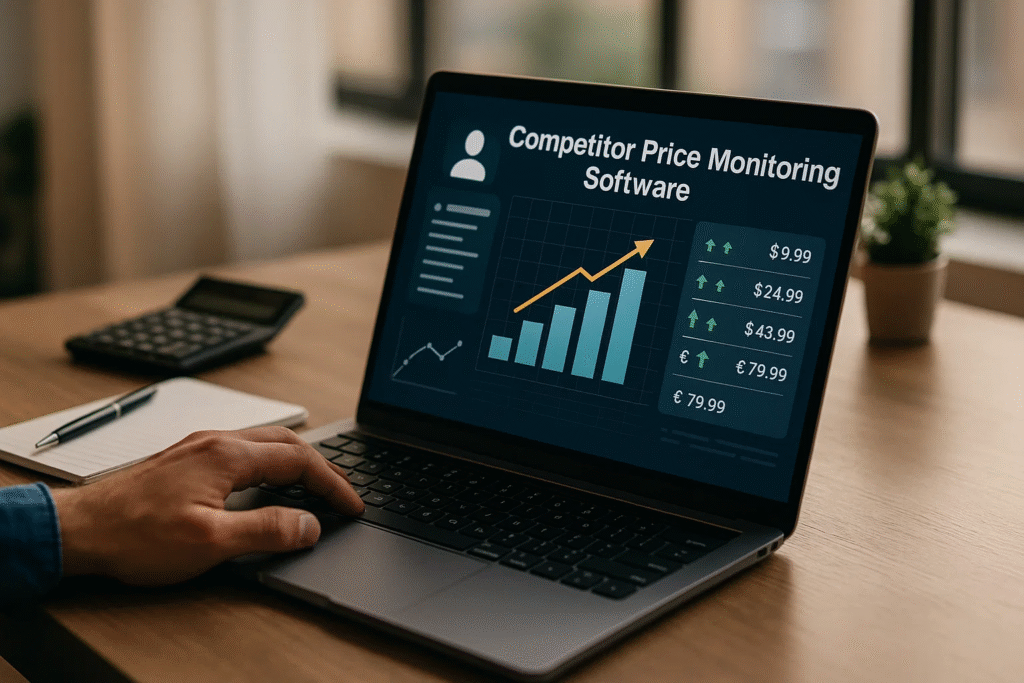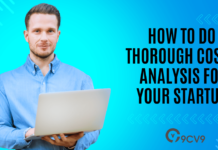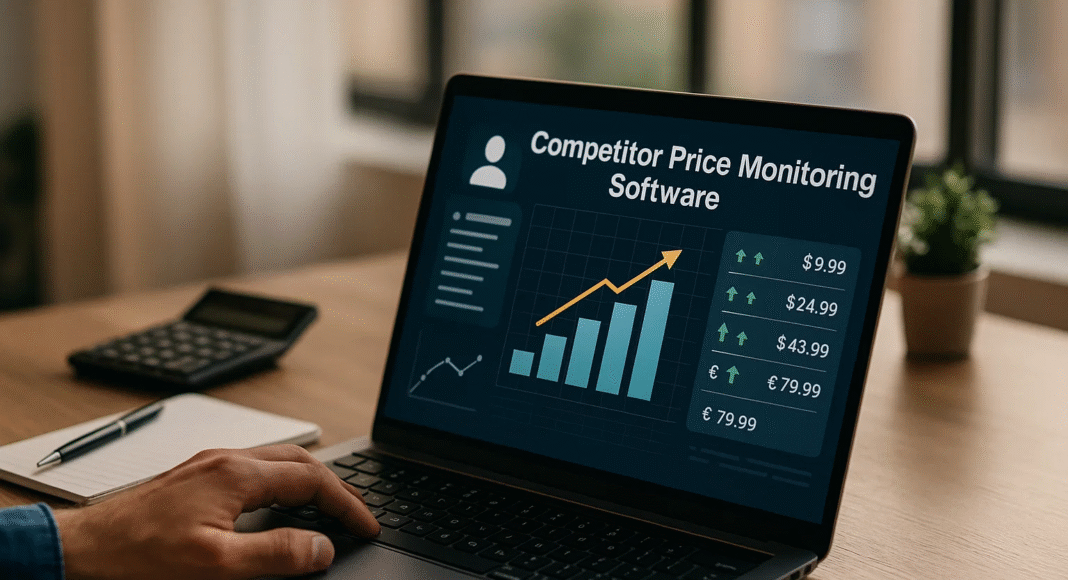Key Takeaways
- Competitor price monitoring software automates tracking of rival prices, enabling timely and data-driven pricing strategies.
- Key features include real-time updates, dynamic product matching, and advanced analytics for comprehensive market insights.
- Using this software helps businesses stay competitive, optimize profits, and respond quickly to market changes.
In today’s highly competitive digital marketplace, pricing has evolved from a static figure on a product tag to a dynamic and data-driven strategy that can make or break a business. Whether you are an e-commerce entrepreneur, a large-scale retailer, or a direct-to-consumer brand, the ability to stay ahead of market shifts and match or outperform your competitors in terms of pricing is essential for survival and growth. As consumer behavior continues to shift toward price sensitivity and comparison shopping, having real-time insights into competitor pricing has become not just a benefit—but a necessity. This is where Competitor Price Monitoring Software enters the equation.

Competitor Price Monitoring Software is a powerful technological solution that enables businesses to track, analyze, and respond to their competitors’ pricing strategies in real time. Gone are the days when pricing decisions were made based on manual checks or occasional market research. In today’s fast-paced digital economy, product prices can change multiple times within a single day across various marketplaces, retail platforms, and regions. Without the aid of an automated and intelligent pricing monitoring system, businesses risk falling behind, losing market share, and missing out on potential revenue opportunities.
This type of software collects data from multiple sources—such as competitor websites, online marketplaces like Amazon and Walmart, and e-commerce platforms—and compiles it into actionable insights. It allows businesses to not only monitor their competitors’ price changes but also understand the patterns and strategies behind them. Advanced platforms even offer AI-driven dynamic pricing capabilities, helping companies make informed pricing decisions on the fly and remain agile in the face of shifting market dynamics.
What makes Competitor Price Monitoring Software so indispensable in today’s landscape is its ability to turn raw pricing data into meaningful intelligence. It empowers pricing managers, marketers, and business owners to make decisions that enhance profit margins, protect brand value, and strengthen their competitive positioning. The software is often equipped with features like automated alerts, real-time dashboards, historical price tracking, and integration with existing e-commerce or ERP systems—making it a comprehensive tool for both operational efficiency and strategic advantage.
Moreover, in industries where price wars are frequent and consumer loyalty is increasingly fragile, having access to accurate and timely competitor pricing data can mean the difference between sustained success and missed opportunities. Businesses that ignore pricing intelligence run the risk of being blindsided by undercutting rivals, overlooked by cost-conscious consumers, or trapped in unprofitable pricing models.
In this comprehensive guide, we will delve deeper into what Competitor Price Monitoring Software is, how it functions, the benefits it delivers, and the challenges businesses might face when implementing it. We will also explore real-world use cases, must-have features, and the latest trends shaping the future of price intelligence. Whether you’re just beginning to consider pricing tools or looking to upgrade your current strategy, understanding how competitor price monitoring works can provide a decisive edge in today’s saturated markets.
Before we venture further into this article, we would like to share who we are and what we do.
About 9cv9
9cv9 is a business tech startup based in Singapore and Asia, with a strong presence all over the world.
With over nine years of startup and business experience, and being highly involved in connecting with thousands of companies and startups, the 9cv9 team has listed some important learning points in this overview of What is Competitor Price Monitoring Software and How It Works.
If your company needs recruitment and headhunting services to hire top-quality employees, you can use 9cv9 headhunting and recruitment services to hire top talents and candidates. Find out more here, or send over an email to [email protected].
Or just post 1 free job posting here at 9cv9 Hiring Portal in under 10 minutes.
What is Competitor Price Monitoring Software and How It Works
- What is Competitor Price Monitoring Software?
- Why is Competitor Price Monitoring Important?
- Key Features of Competitor Price Monitoring Software
- How Does Competitor Price Monitoring Software Work?
- Use Cases of Competitor Price Monitoring Software
- Benefits of Using Competitor Price Monitoring Software
- Challenges and Limitations
- How to Choose the Right Competitor Price Monitoring Tool
- Future Trends in Price Monitoring Technology
1. What is Competitor Price Monitoring Software?
Competitor Price Monitoring Software is a digital tool that enables businesses to track, analyze, and respond to their competitors’ pricing strategies in real time across various sales channels. This software is widely used by e-commerce retailers, global brands, and pricing strategists to optimize pricing, remain competitive, and increase profitability.
Understanding the Concept of Price Monitoring Software
Definition and Core Purpose
- Competitor Price Monitoring Software refers to a data-driven solution that:
- Continuously tracks prices of identical or similar products sold by competitors.
- Collects and organizes real-time price intelligence from websites, marketplaces, and third-party retailers.
- Helps businesses adapt their pricing based on real-world market dynamics.
Who Uses It?
- E-commerce Retailers
- Example: An online electronics store uses the tool to track Amazon, Walmart, and Best Buy prices daily.
- Brands and Manufacturers
- Example: A fashion brand monitors whether resellers are following its Minimum Advertised Price (MAP) policy.
- B2B Suppliers
- Monitor pricing in competitive tender environments.
- Marketplace Sellers
- Compete dynamically on platforms like Amazon, eBay, Lazada, and Flipkart.
Key Functions of Competitor Price Monitoring Software
Real-Time Price Scraping and Tracking
- Continuously collects product prices from:
- Competitor websites.
- Online marketplaces (Amazon, Alibaba, Rakuten).
- Retail aggregator sites (Google Shopping, PriceGrabber).
- Uses web scraping, APIs, or feeds to extract data.
Product Matching Algorithms
- Identifies identical or similar products across platforms.
- Uses AI or manual matching to align SKUs, titles, brands, and features.
- Helps prevent false comparisons and ensures accurate data.
Price Change Notifications and Alerts
- Sends instant alerts when a competitor:
- Lowers or raises their price.
- Offers promotional discounts or bundle deals.
- Changes stock availability or shipping costs.
Dynamic Pricing Integration
- Some software allows for automated price adjustments.
- Example: If a competitor drops the price of a laptop by 10%, the business can choose to match or beat it instantly.
What Makes It Different from General Price Analysis Tools?
| Feature | Competitor Price Monitoring Software | General Price Analysis Tools |
|---|---|---|
| Real-Time Data | Yes | Often No |
| Competitor-Specific Insights | Yes | No |
| Automated Alerts | Yes | No |
| Dynamic Pricing Support | Often Integrated | Rare |
| Marketplace Monitoring | Yes (Amazon, eBay, Walmart, etc.) | Limited |
| MAP Compliance Monitoring | Yes | No |
| AI-Based Product Matching | Yes | No or Limited |
Common Channels Monitored by the Software
Marketplaces
- Amazon
- eBay
- Rakuten
- Walmart Marketplace
- Lazada, Shopee (SEA region)
Brand Websites
- Competitor-owned eCommerce platforms
- Direct-to-consumer portals
Price Aggregators
- Google Shopping
- Shopzilla
- Idealo
Examples of How Businesses Use It
Retail Electronics Example
- A company selling mobile phones online uses Prisync to monitor over 50 competitors across regions.
- They receive alerts when rivals discount specific models.
- Adjustments are made automatically based on pre-set pricing rules.
Fashion Brand Example
- A luxury handbag brand uses Minderest to track reseller pricing.
- The tool flags violations of MAP policies, allowing the brand to take corrective action.
B2B Wholesale Supplier
- A construction materials supplier uses Dataweave to track tender-based pricing of rival suppliers across regions.
- Gains insight into pricing trends before submitting bids.
Benefits of Understanding What This Software Does
Improves Pricing Accuracy
- Helps eliminate guesswork in setting product prices.
- Makes pricing decisions more data-driven and market-aware.
Increases Profitability
- Avoids unnecessary price reductions.
- Enables strategic pricing to maximize margins while remaining competitive.
Enhances Market Responsiveness
- Businesses can react swiftly to competitor moves.
- Maintains customer trust by offering timely promotions or better value.
Supports Long-Term Strategy
- Enables forecasting of pricing trends.
- Informs promotional planning, stock management, and marketing.
Conclusion of the Section
Competitor Price Monitoring Software serves as the backbone of competitive pricing strategies in modern commerce. By combining real-time data acquisition, intelligent analysis, and actionable insights, this software empowers businesses to make informed decisions that drive sales, preserve margins, and strengthen their market position. Whether used by global retailers or niche market sellers, it is an indispensable tool in the digital pricing ecosystem.
2. Why is Competitor Price Monitoring Important?
In today’s hyper-connected digital economy, the importance of competitor price monitoring cannot be overstated. With dynamic pricing models, aggressive market competition, and increasingly price-sensitive consumers, businesses must maintain continuous visibility into how their competitors are pricing similar products or services. This not only impacts sales but directly affects brand perception, profit margins, and long-term sustainability. Competitor price monitoring allows businesses to stay agile, maintain profitability, and achieve a strong competitive advantage in crowded markets.
Maintaining Market Competitiveness
Stay Aligned with Market Trends
- Regular monitoring ensures pricing is never too high or too low relative to competitors.
- Enables real-time reactions to sudden price changes, flash sales, or promotional discounts.
Benchmark Against Industry Standards
- Businesses can use competitor pricing as a benchmark to:
- Validate their own pricing decisions.
- Identify market positioning (premium, mid-tier, budget).
Example:
- An online sports apparel brand monitors rival prices during seasonal sales (e.g., Black Friday) to ensure they remain attractive to deal-seeking customers.
Optimizing Pricing Strategy for Profitability
Avoid Undercutting and Margin Erosion
- Without proper monitoring, businesses often reduce prices unnecessarily.
- Knowing competitors’ prices helps maintain optimal margins while staying competitive.
Identify Price Elasticity Opportunities
- Recognize where customers are willing to pay more based on brand value, features, or shipping speed.
Example:
- A tech accessory store uses price monitoring software to see that its premium chargers are priced lower than similar products on Amazon, enabling them to raise prices slightly without losing customers.
Enhancing Sales Performance
Attract More Price-Sensitive Customers
- Consumers often compare prices across platforms before purchasing.
- Competitive pricing boosts conversion rates, especially in high-demand categories.
Improve Cart Abandonment Rates
- If users find a better deal elsewhere, they abandon carts.
- Monitoring allows real-time adjustments to prevent revenue leakage.
Example:
- A cosmetics brand sees an increase in abandoned carts. After reviewing competitor price drops, they temporarily match those prices, reducing cart abandonment by 22%.
Building a Value-Based Brand Positioning
Position Your Brand Intelligently
- Helps companies define whether they want to be perceived as:
- Low-cost leaders
- Value-for-money providers
- Premium product specialists
Maintain Consistent Brand Value
- Prevents price wars that can devalue products and damage long-term brand equity.
Monitor Reseller and MAP Violations
- Brands can enforce Minimum Advertised Price (MAP) policies by tracking resellers’ pricing behavior.
Example:
- A luxury watchmaker uses competitor price monitoring to ensure third-party distributors aren’t listing items below MAP, preserving the premium brand image.
Supporting Strategic Decision-Making
Improves Inventory Planning
- Insights into competitor stock availability and promotions can guide your own inventory strategy.
Inform Promotional Campaigns
- Knowing when competitors run sales helps time your own discounts for maximum impact.
Enable Dynamic Pricing Models
- Integrates with pricing algorithms to automatically adjust prices in response to market changes.
Identifying New Market Opportunities
Track New Entrants and Pricing Gaps
- Spot underserved niches or pricing gaps your business can fill.
Detect Unusual Market Activity
- Anomalies in competitor pricing can indicate clearance sales, exits, or major supply chain changes.
Example:
- A home furniture retailer identifies that a new competitor is pricing below cost. They choose not to engage in a price war but instead double down on service and quality messaging.
Comparison Table: Traditional vs. Data-Driven Pricing Strategy
| Feature/Impact Area | Traditional Pricing (No Monitoring) | With Competitor Price Monitoring |
|---|---|---|
| Decision Basis | Assumptions or fixed cost margins | Real-time market data |
| Response Time to Price Changes | Days or weeks | Instant or near real-time |
| Visibility into Market Dynamics | Limited | High |
| Risk of Over/Underpricing | High | Low |
| Sales Optimization | Unpredictable | Continuous |
| Competitive Advantage | Weak | Strong |
| Brand Positioning Control | Low | High |
| Profit Margin Control | Reactive | Proactive |
Use Case Examples by Industry
E-commerce and Retail
- Amazon sellers use RepricerExpress or Feedvisor to automatically reprice products based on competitor activity.
- Results in improved Buy Box wins and increased sales volumes.
Travel and Hospitality
- Airlines and hotels monitor competitor rates daily to adjust their room or ticket pricing dynamically.
- Booking platforms like Expedia and Kayak aggregate this data as a service.
SaaS and Digital Products
- Software providers use tools like Pricefx or Competera to track pricing on comparable tools.
- Helps justify their pricing tiers and value-added features.
Long-Term Strategic Benefits
Customer Loyalty
- Customers return to brands that consistently offer fair, competitive pricing.
Market Adaptability
- Companies that monitor prices adapt more quickly to inflation, cost increases, or regulatory changes.
Data-Backed Growth
- Price monitoring forms part of a broader pricing intelligence strategy that includes:
- Competitive benchmarking
- Market segmentation
- Customer value modeling
Conclusion of the Section
Competitor price monitoring is not merely a tactical tool—it is a strategic asset that enables data-backed pricing decisions, protects profitability, and enhances competitiveness in an increasingly volatile market landscape. Whether you’re operating in retail, SaaS, B2B, or hospitality, understanding how your competitors price their offerings—and how those prices shift in real-time—can mean the difference between leading the market and lagging behind. Businesses that leverage price monitoring not only stay relevant but often gain the upper hand in the pricing battle that defines modern commerce.
3. Key Features of Competitor Price Monitoring Software
Competitor price monitoring software offers a suite of powerful features designed to give businesses accurate, real-time insights into market pricing dynamics. These tools go beyond basic price checks, providing automation, analytics, alerts, and strategic guidance to drive intelligent pricing decisions. Whether you operate an e-commerce store, a retail chain, or a SaaS company, these key features can transform the way you manage pricing and respond to competitors.
Real-Time Price Tracking
Instant Data Collection and Updates
- Automatically tracks competitor pricing across:
- Online marketplaces (e.g., Amazon, eBay, Walmart)
- Retail websites
- Comparison shopping engines
- Enables live updates on price fluctuations, allowing businesses to react instantly.
Dynamic Pricing Compatibility
- Integrates with your own pricing system to adjust prices based on real-time data.
- Supports personalized pricing strategies based on competitor behavior.
Example:
- A fashion retailer tracks competitors’ dress prices across multiple regions using Prisync. Upon detecting a 20% markdown by a competitor, it instantly reduces its own price on the same product by 15% to remain competitive.
Automated Alerts and Notifications
Custom Alert Triggers
- Users can set thresholds for:
- Price drops
- Price hikes
- Stock-outs
- Promotional offers
Multi-Channel Notifications
- Alerts delivered via email, dashboard notifications, or API integrations.
- Enables fast decision-making and competitive response.
Example:
- A travel agency uses automated alerts to detect when rival agencies reduce holiday package prices, enabling immediate promotional counter-offers.
Historical Price Analytics
Price Trends Over Time
- Visualizes how competitor prices evolve over days, weeks, or months.
- Helps businesses understand seasonal trends, promotional patterns, and pricing strategies.
Competitor Behavior Analysis
- Tracks consistency and volatility in pricing for each competitor.
- Supports forecasting of future pricing behavior.
Chart Example: Price Trends Over 6 Months
| Month | Your Price | Competitor A | Competitor B |
|---|---|---|---|
| January | $79 | $82 | $75 |
| February | $79 | $81 | $74 |
| March | $77 | $79 | $73 |
| April | $76 | $76 | $70 |
| May | $75 | $75 | $72 |
| June | $74 | $73 | $71 |
This chart reveals how Competitor B initiated price drops earlier than others—an insight used to predict upcoming promotions.
Competitor Assortment Monitoring
Product Availability Tracking
- Monitors whether competitors have products in stock or have temporarily removed them.
- Enables businesses to raise prices slightly during competitor stock-outs.
New Product Detection
- Automatically detects when a competitor introduces new products.
- Supports product strategy, inventory planning, and promotional tactics.
Example:
- A laptop reseller uses product assortment monitoring to identify when a rival runs out of a popular model. They then highlight the product in a featured promotion while increasing the price slightly for higher margin.
Advanced Price Comparison Dashboards
Side-by-Side Comparisons
- Displays your prices versus competitors’ across multiple SKUs or categories.
- Enables instant detection of pricing gaps or mismatches.
Search and Filter Capabilities
- Allows sorting by brand, product category, channel, or region.
- Makes analysis faster and more precise.
Table Example: Price Comparison Snapshot
| Product SKU | Your Price | Competitor A | Competitor B | Difference from Lowest |
|---|---|---|---|---|
| 101-Widget | $49.99 | $47.99 | $52.00 | +$2.00 |
| 102-Gadget | $89.00 | $91.00 | $85.00 | -$4.00 |
| 103-Toolkit | $120.00 | $125.00 | $118.00 | +$2.00 |
This dashboard helps identify where you’re overpriced or underpriced compared to competitors.
Rule-Based Dynamic Pricing Engine
Automated Repricing Rules
- Create rules to:
- Match lowest price
- Undercut by fixed percentage
- Maintain minimum profit margins
- Works across platforms like Shopify, Magento, Amazon, and WooCommerce.
Avoid Price Wars
- Tools ensure that automated repricing doesn’t lead to margin-killing price wars by setting floors and ceilings.
Example:
- An electronics seller configures rules to always price items $0.50 below the lowest competitor—but never go below 15% profit margin.
Brand and MAP (Minimum Advertised Price) Compliance Tracking
MAP Violation Alerts
- Identifies unauthorized resellers or vendors violating pricing agreements.
- Protects brand integrity and supports enforcement actions.
Geo-Specific Monitoring
- Enables monitoring across various markets to detect regional MAP violations.
Example:
- A luxury watch brand uses MAP monitoring features to detect price violations on European retailer websites. They use the report to send formal takedown notices.
Multi-Region and Multi-Currency Support
Global Pricing Visibility
- Supports different currencies and taxes across international markets.
- Provides geo-specific insights on pricing trends.
Exchange Rate Management
- Automatically converts foreign prices using live exchange rates.
- Helps in understanding true competitiveness globally.
Example:
- A Singapore-based software company tracks how its product is priced in the UK, US, and Australia. It adjusts local prices based on regional competitor pricing and currency fluctuations.
API Integration and Data Export
Seamless System Integration
- Syncs with:
- ERP systems
- E-commerce platforms
- BI dashboards
- Enables full automation of data flows.
Custom Reporting and Export Formats
- Exports data in CSV, Excel, JSON, or via direct API.
- Facilitates easy sharing with marketing, finance, and sales teams.
User Access Management and Team Collaboration
Role-Based Permissions
- Allows access control for team members based on roles (e.g., marketing vs. pricing team).
- Ensures data privacy and accountability.
Collaborative Dashboards
- Shared views across teams help align pricing strategies with marketing and inventory planning.
Summary Table: Key Features and Their Business Value
| Feature | Benefit to Business | Example Use Case |
|---|---|---|
| Real-Time Price Tracking | Instant reactions to market changes | Adjusting prices during a flash sale |
| Automated Alerts & Notifications | Proactive decision-making | Responding to price drops instantly |
| Historical Price Analytics | Strategic planning based on trends | Anticipating competitor promotions |
| Assortment Monitoring | Opportunity detection during stock-outs | Raising prices when rivals run out |
| Advanced Dashboards | Simplified analysis across product lines | Identifying overpriced items |
| Dynamic Pricing Rules | Pricing automation with guardrails | Avoiding profit margin erosion |
| MAP Compliance Tracking | Brand protection and policy enforcement | Enforcing reseller agreements |
| Multi-Currency Support | Global pricing intelligence | Localizing pricing in foreign markets |
| API & Data Export | Full system integration and reporting | Automating reporting to pricing teams |
| Role-Based Access | Secure and collaborative pricing management | Team-based pricing strategy execution |
Conclusion of the Section
Competitor price monitoring software offers a comprehensive feature set that transforms how businesses interact with real-time market pricing data. From dynamic pricing engines to historical analytics, these tools empower companies to stay agile, protect margins, and seize market opportunities as they arise. By leveraging these advanced capabilities, organizations can make informed, strategic decisions that fuel revenue growth, build brand resilience, and solidify their competitive edge in even the most volatile markets.
4. How Does Competitor Price Monitoring Software Work?
Competitor price monitoring software operates through a systematic process that gathers, analyzes, and interprets competitor pricing data to provide actionable insights. The entire workflow is powered by data crawling, intelligent matching algorithms, and real-time analytics that support agile pricing strategies. Below is a breakdown of how these systems function behind the scenes.
1. Data Collection: Web Crawling and Scraping
How It Works:
- The software uses web crawlers or scrapers to extract pricing data from:
- Competitor websites
- Online marketplaces (e.g., Amazon, eBay)
- Google Shopping and price comparison sites
- Mobile apps (via API integrations)
What It Captures:
- Product name and SKU
- Current price and old price (if available)
- Availability status (in-stock or out-of-stock)
- Promotion tags or discounts
- Shipping cost and delivery time
Real-World Example:
- An electronics retailer uses Price2Spy to scan over 100 competitor websites daily. The software scrapes prices for thousands of SKUs including televisions, mobile phones, and accessories.
Chart: Types of Data Collected by Web Crawlers
| Data Type | Description | Importance for Monitoring |
|---|---|---|
| Product Name | Identifies exact match or variations | Crucial for correct mapping |
| Current Price | Most recent selling price | Core metric for price strategy |
| Stock Status | Available, limited, or out of stock | Enables supply-based decisions |
| Promotions | Discounts, coupons, bundle offers | Detects marketing tactics |
| Timestamp | When the price was captured | Validates freshness of data |
2. Product Matching Algorithms
How It Works:
- After data collection, the software applies product matching logic to ensure the competitor’s product corresponds accurately to the user’s product catalog.
- Matching methods include:
- Exact Match (based on SKU/barcode)
- Fuzzy Match (based on product name or description similarity)
- Image Recognition (for advanced tools)
Why It Matters:
- Accurate matching ensures correct price comparisons.
- Prevents misalignment that could lead to incorrect pricing adjustments.
Example:
- A beauty brand uses Intelligence Node, which matches similar makeup products across competitors using AI and machine learning, even when product titles vary slightly.
Table: Product Matching Techniques
| Technique | Methodology | Suitable For |
|---|---|---|
| Exact Match | Matches by UPC, SKU, EAN | Identical items on known platforms |
| Fuzzy Matching | Uses natural language processing (NLP) | Similar products with variant names |
| Image Matching | Compares product photos using AI vision | Apparel, home decor, cosmetics |
3. Data Normalization and Cleansing
Key Functions:
- Converts extracted data into a standardized format.
- Removes inconsistencies caused by:
- Varying currency formats
- Different measurement units (e.g., inches vs. cm)
- Mixed language descriptions
Benefits:
- Ensures clean and uniform datasets for analysis.
- Makes price comparison across countries and platforms more reliable.
Example:
- A global fashion brand selling in USD, GBP, and EUR uses Omnia Retail to convert all competitor pricing into a unified currency format, enabling streamlined analysis.
4. Price Comparison and Competitive Analysis
Core Capabilities:
- Displays your product prices versus competitor prices in:
- Side-by-side tables
- Visual dashboards
- Interactive graphs
Features:
- Highlights:
- Cheapest competitor
- Price gaps
- Competitor trends over time
Chart: Competitor Price Gap Analysis (Sample)
| Product SKU | Your Price | Competitor A | Competitor B | Lowest Price | Price Gap (Lowest vs. Yours) |
|---|---|---|---|---|---|
| X123 | $59.99 | $57.99 | $61.50 | $57.99 | -$2.00 |
| Y456 | $120.00 | $115.00 | $119.00 | $115.00 | -$5.00 |
| Z789 | $75.00 | $76.00 | $74.00 | $74.00 | -$1.00 |
5. Intelligent Alerts and Notifications
How It Works:
- Users can set custom thresholds for alerts such as:
- Price drops below a certain value
- Competitor pricing changes by X%
- Stock-outs or back-in-stock events
Delivery Methods:
- Email summaries
- Real-time notifications on the dashboard
- API push to ERP or CRM systems
Example:
- A SaaS company monitors competitor subscription pricing. When a rival offers a 30% discount for Black Friday, the system alerts the sales team to deploy a counter promotion.
6. Dynamic Pricing Execution (Optional Feature)
Functionality:
- Some software includes dynamic pricing engines that adjust your prices in real-time based on competitive signals.
Customization Options:
- Undercut competitor by fixed percentage
- Maintain specific profit margins
- Match lowest price only if stock is available
Real-World Use:
- A pet supplies e-commerce store uses Feedvisor to automate price changes on Amazon Marketplace based on competitor price changes and Buy Box eligibility.
7. Reporting and Business Intelligence
Analytical Features:
- Generates in-depth reports including:
- Pricing trends
- Revenue impact analysis
- Margin erosion due to competitor activity
- Offers filters by category, brand, region, or sales channel.
Export & Integration:
- Reports can be exported in PDF, Excel, or CSV.
- Integrated into BI platforms such as Tableau, Power BI, or Looker.
Example:
- A multi-category retailer uses the BI dashboard in Minderest to see how its product margins were affected over time by aggressive competitor discounting.
Chart: Margin Trend Analysis Example
| Month | Average Cost | Avg. Selling Price | Margin | Top Competitor Price |
|---|---|---|---|---|
| Jan | $40.00 | $60.00 | 50% | $58.00 |
| Feb | $40.00 | $57.00 | 42.5% | $55.00 |
| Mar | $40.00 | $52.00 | 30% | $51.00 |
| Apr | $40.00 | $49.00 | 22.5% | $47.50 |
8. Feedback Loops and Strategic Optimization
Feedback to Stakeholders:
- Insights from price monitoring are shared with:
- Pricing analysts
- Product managers
- Marketing teams
Strategic Use:
- Supports:
- Market entry strategies
- Inventory clearance planning
- Promotion calendar development
Example:
- A consumer electronics brand uses feedback from competitor price tracking to delay launching a new smartwatch until a major competitor concludes a discount campaign.
Summary Table: Process Flow of Competitor Price Monitoring Software
| Stage | Function | Output |
|---|---|---|
| Web Crawling & Data Collection | Scrapes competitor data from the web | Raw pricing and product information |
| Product Matching | Aligns competitor data with own catalog | Comparable product dataset |
| Data Normalization | Cleans and formats data uniformly | Standardized dataset |
| Price Analysis & Visualization | Compares prices across SKUs | Dashboards, charts, price tables |
| Alerts & Notifications | Sends real-time alerts for price changes | Actionable notifications |
| Dynamic Pricing (optional) | Automatically updates prices | Repriced listings |
| Reporting & BI | Provides strategic insights and analytics | Detailed reports and export files |
| Feedback Integration | Shares insights across departments | Enhanced decision-making |
Conclusion of the Section
Competitor price monitoring software operates as a sophisticated, multi-layered system that streamlines competitive intelligence for pricing strategy. By leveraging automated web crawling, precise product matching, advanced analytics, and optional dynamic pricing, businesses gain a significant edge in today’s fast-moving digital marketplace. Whether used by e-commerce giants or niche players, these tools provide the actionable insight required to react smartly to competition, safeguard profitability, and optimize market positioning.
5. Use Cases of Competitor Price Monitoring Software
Competitor price monitoring software serves a wide array of strategic functions across different industries and business models. From retail and e-commerce to travel, SaaS, and manufacturing, organizations deploy this software to gain real-time pricing intelligence, safeguard market share, and increase revenue.
This section explores the most impactful use cases, highlighting how businesses apply price tracking solutions in various real-world scenarios.
1. Dynamic Pricing Optimization
Use Case Overview:
- Businesses use competitor pricing data to automatically adjust their prices in real-time, maintaining competitiveness while protecting profit margins.
Key Applications:
- E-commerce marketplaces
- Online travel agencies
- Subscription-based SaaS models
Benefits:
- Increased conversion rates
- Optimized profit margins
- Better win rate in competitive bids
Example:
- An online retailer selling electronics uses Prisync to automatically reduce its price by 3% below the lowest competitor for high-volume items such as Bluetooth speakers.
Table: Before vs. After Using Dynamic Pricing
| Product | Price Before | Competitor Price | New Dynamic Price | Resulting Sales Increase |
|---|---|---|---|---|
| Bluetooth Speaker A | $89.99 | $85.00 | $82.50 | +27% |
| Laptop Sleeve B | $24.99 | $22.00 | $21.34 | +15% |
| Gaming Mouse C | $49.99 | $46.99 | $45.50 | +22% |
2. New Market Entry and Expansion
Use Case Overview:
- Companies expanding into new geographic markets use competitor price monitoring to assess price benchmarks, consumer expectations, and margin feasibility.
Key Applications:
- Cross-border e-commerce
- DTC brands entering international markets
Benefits:
- Accurate pricing localization
- Faster go-to-market strategies
- Competitive benchmarking in unknown markets
Example:
- A fashion brand entering the Southeast Asian market uses Intelligence Node to study local pricing trends for similar apparel on Shopee and Lazada before launching.
Chart: Average Price Comparison by Region (Sneaker Product Line)
| Country | Avg. Competitor Price | Recommended Entry Price | Local Currency |
|---|---|---|---|
| Singapore | 89 SGD | 85 SGD | SGD |
| Indonesia | 650,000 IDR | 620,000 IDR | IDR |
| Thailand | 990 THB | 960 THB | THB |
3. Promotional Intelligence and Campaign Benchmarking
Use Case Overview:
- Businesses monitor competitor discounts, bundle deals, and seasonal sales to align or counter-strategize their marketing campaigns.
Key Applications:
- Black Friday/Cyber Monday promotions
- Limited-time online deals
- Loyalty and bundle pricing programs
Benefits:
- Real-time visibility into competitor marketing tactics
- Better ROI on promotional campaigns
- Avoidance of margin loss due to over-discounting
Example:
- A beauty e-commerce platform tracks Sephora’s monthly promotions via Competera, helping the marketing team adjust ad spend and timing.
Table: Competitor Campaign Response Strategy
| Campaign Date | Competitor Offer | Platform | Response Strategy | Result |
|---|---|---|---|---|
| Nov 25 | 20% off all skincare | Sephora | Match with 15% + free gift | Maintained margin, +12% ROI |
| Dec 15 | Buy 1 Get 1 on lipsticks | Ulta Beauty | No match | Stable conversion |
| Jan 5 | Flash 30% off perfumes | Amazon | 25% discount on select | Slight dip, margin protected |
4. MAP (Minimum Advertised Price) Compliance Monitoring
Use Case Overview:
- Brands track online sellers to ensure they comply with MAP policies, preventing brand erosion and unfair competition.
Key Applications:
- Consumer electronics
- Home appliances
- Health supplements
Benefits:
- Protects brand equity
- Reduces reseller disputes
- Supports legal enforcement of MAP agreements
Example:
- A smartwatch manufacturer uses Wiser Solutions to monitor unauthorized resellers violating MAP policies on Amazon and eBay.
Table: MAP Violation Tracker (Last 30 Days)
| Seller Name | Platform | MAP Price | Listed Price | Violation Detected | Action Taken |
|---|---|---|---|---|---|
| TechMart Outlet | Amazon | $149.99 | $129.99 | Yes | Notice issued |
| DealsNow | Walmart | $99.00 | $99.00 | No | – |
| FlashSales Pro | eBay | $120.00 | $115.50 | Yes | Listing flagged |
5. Product Assortment and Gap Analysis
Use Case Overview:
- Retailers compare their product catalog with competitors to identify product gaps, overlaps, and opportunities for SKU expansion.
Key Applications:
- Category management
- Private label product launch
- Inventory optimization
Benefits:
- Informed product development
- More competitive assortment
- Data-driven inventory planning
Example:
- A home décor brand uses Minderest to identify that competitors offer twice as many mid-range candle variants, leading to a targeted expansion in that segment.
Chart: Product Coverage Comparison by Category
| Category | Your SKUs | Competitor A | Competitor B | Market Gap Detected |
|---|---|---|---|---|
| Table Lamps | 45 | 47 | 52 | No |
| Scented Candles | 12 | 34 | 29 | Yes (Add 15 SKUs) |
| Wall Mirrors | 25 | 21 | 20 | Competitive |
6. Price Trend Analysis and Historical Benchmarking
Use Case Overview:
- Companies monitor historical price movements to understand seasonality, competitor strategy evolution, and consumer response trends.
Key Applications:
- Long-term pricing strategy
- Budgeting and forecasting
- Strategic category review
Benefits:
- Insightful price timing for promotions
- Early warnings of price wars
- Smarter forecasting for procurement
Example:
- A laptop accessories brand identifies that competitor prices for laptop stands typically drop 10% in Q4, enabling them to pre-plan Q3 inventory.
Chart: Historical Pricing Trend for Laptop Stands (2023)
| Month | Avg. Competitor Price | Avg. Market Discount | Notable Event |
|---|---|---|---|
| January | $29.99 | 5% | New Year sale |
| April | $27.50 | 8% | Spring promo season |
| August | $28.00 | 6% | Back-to-school season |
| November | $24.00 | 18% | Black Friday |
7. Strategic Positioning for DTC and Niche Brands
Use Case Overview:
- Direct-to-consumer (DTC) brands use pricing intelligence to differentiate on value, monitor luxury vs. budget competitors, and maintain positioning.
Key Applications:
- Niche skincare, fashion, or food brands
- Lifestyle startups
- Ethical/sustainable product lines
Benefits:
- Preserves brand uniqueness
- Aligns price with perceived quality
- Reduces price dilution from discount competition
Example:
- A DTC ethical skincare brand tracks budget and luxury rivals to position its facial oil at a “mid-premium” level using insights from Skuuudle.
Table: Competitive Positioning Framework
| Brand Type | Avg. Price (30ml Facial Oil) | Positioning Strategy |
|---|---|---|
| Budget Brand A | $12.00 | Avoid undercutting |
| Mid-Premium (You) | $24.00 | Highlight sustainability |
| Luxury Brand B | $55.00 | Offer value-based alternatives |
Conclusion of the Section
Competitor price monitoring software has evolved beyond simple price comparison tools to become essential for a wide spectrum of strategic business operations. Whether applied for dynamic pricing, new market entry, promotional planning, MAP enforcement, or competitive positioning, these tools provide granular visibility that empowers agile decision-making.
By understanding specific use cases and aligning software capabilities with organizational goals, companies across various sectors can enhance profitability, maintain pricing discipline, and respond to competitors with speed and precision.
6. Benefits of Using Competitor Price Monitoring Software
In today’s intensely competitive digital economy, businesses must continuously evolve their pricing strategies to stay relevant, profitable, and customer-centric. Competitor price monitoring software delivers a wide range of advantages by automating and optimizing the way companies track, analyze, and respond to market pricing changes.
From gaining real-time insights to driving strategic pricing decisions, the benefits of these tools extend across marketing, sales, operations, and executive decision-making levels.
1. Real-Time Competitive Intelligence
Why It Matters:
- In fast-paced markets, price changes happen frequently. Manual tracking often results in outdated information and missed opportunities.
Benefits:
- Access to live competitor pricing and stock status
- Early alerts on price drops, promotions, or new entries
- Enables proactive responses rather than reactive decision-making
Examples:
- An electronics retailer uses Price2Spy to detect sudden discounts by competitors on smartphones, triggering immediate promotional alignment.
Chart: Impact of Real-Time Monitoring on Response Speed
| Action Triggered | Without Software | With Price Monitoring Tool |
|---|---|---|
| Detect Competitor Discount | 48 hours | Real-time (5–10 minutes) |
| Adjust Product Price | 2–3 days | Within 1 hour |
| Update Campaign Messaging | 2 days | Same day |
2. Improved Pricing Strategy and Margin Optimization
Why It Matters:
- Effective pricing impacts both conversion rates and profit margins. Competitive price tracking ensures alignment between market conditions and profitability goals.
Benefits:
- Dynamic pricing recommendations based on market position
- Identification of price-sensitive vs. value-based products
- Improved margin control through smart repricing
Examples:
- A SaaS company monitors rivals to maintain a value-based tiered pricing model that remains competitive without resorting to heavy discounts.
Table: Price Strategy Outcomes Before and After Using Monitoring Tool
| KPI | Before Tool | After Tool (Using Omnia Retail) |
|---|---|---|
| Avg. Gross Margin (%) | 22% | 27% |
| Price Change Frequency | Monthly | Weekly |
| Underpriced SKUs Detected | 0 | 120 |
3. Enhanced Customer Acquisition and Retention
Why It Matters:
- Today’s price-conscious consumers often compare options across platforms. Offering the most competitive prices increases traffic and improves customer loyalty.
Benefits:
- Attract price-sensitive shoppers
- Improve shopping cart conversion rates
- Foster long-term retention through consistent value
Examples:
- A furniture retailer increased its customer acquisition by 18% after using Skuuudle to undercut competitors on fast-selling SKUs without affecting profit margins.
4. Streamlined Promotional Planning
Why It Matters:
- Promotional misalignment—either underpricing or over-discounting—can lead to lost revenue or eroded brand value.
Benefits:
- Helps benchmark the effectiveness of competitor offers
- Enables data-driven planning for sales events (e.g., Black Friday)
- Prevents unnecessary discounting by identifying true competitive threats
Examples:
- A fashion e-commerce brand used Intelligence Node to sync their holiday sales strategy with market timing, avoiding premature discounts.
Table: Sales Event Strategy Improved Through Monitoring
| Sales Event | Competitor Strategy Detected | Your Adjusted Action | Outcome |
|---|---|---|---|
| Cyber Monday | Flash Sale – 40% | Tiered Discounts (15–35%) | Increased Avg. Order Value |
| Valentine’s Week | Bundle Promotions | Free shipping + Gift card | +22% Conversion Rate |
5. Greater Visibility into Market Positioning
Why It Matters:
- Businesses need to understand where their prices fall within the broader market to maintain or reposition their brand strategically.
Benefits:
- Identify whether your pricing is premium, mid-range, or budget
- Compare against local and global competitors
- Make informed positioning decisions across regions or channels
Examples:
- A skincare brand used Competera to identify that its product pricing in Asia was perceived as luxury, leading to packaging and messaging changes.
Chart: Pricing Positioning Matrix (Facial Moisturizer, 50ml)
| Brand | Price (USD) | Market Position |
|---|---|---|
| Your Brand | $35.00 | Premium |
| Competitor A | $22.00 | Mid-range |
| Competitor B | $12.50 | Budget |
| Competitor C | $45.00 | Luxury |
6. Faster Reaction Time to Market Changes
Why It Matters:
- Market prices can shift rapidly due to seasonality, new product launches, or competitor strategies. Fast response helps businesses retain a competitive edge.
Benefits:
- Minimize stockouts or overstock due to price-driven demand
- Quickly address price wars or strategic discounts
- Agile campaign deployment based on competitor movements
Examples:
- A sporting goods store reacted within 2 hours to a 20% discount on hiking boots by a major competitor using Minderest, preserving market share.
7. MAP and Brand Policy Enforcement
Why It Matters:
- Minimum Advertised Price (MAP) policies protect brand equity and ensure fair play across sales channels.
Benefits:
- Detect unauthorized pricing violations in real time
- Automate enforcement and notify non-compliant sellers
- Support distributor relationships by enforcing uniform pricing
Examples:
- A premium headphone brand used Wiser Solutions to detect 47 MAP violations across third-party sellers and issued automated takedown notices.
8. Better Inventory and Demand Forecasting
Why It Matters:
- Monitoring price movements across the market provides indirect insights into demand trends and inventory cycles.
Benefits:
- Identify high-velocity SKUs based on competitor restocking
- Forecast potential surges based on pre-sale discounts
- Align procurement with competitive demand signals
Examples:
- A home appliance brand noticed repeated price drops on a mid-range vacuum model by competitors, signaling slow-moving inventory, and reduced its own purchase order volume accordingly.
9. Informed Expansion into New Product Categories
Why It Matters:
- Expanding into new categories requires a thorough understanding of the pricing landscape to ensure competitiveness from the outset.
Benefits:
- Identify pricing sweet spots for new product lines
- Avoid entering oversaturated or high-discount segments
- Align cost structure with viable price points
Examples:
- A fitness brand used Prisync to evaluate pricing in the resistance band and foam roller categories before launching new SKUs.
Table: Pre-Entry Competitive Price Benchmarking
| Product Category | Avg. Price (Top 5 Competitors) | Your Target Price | Entry Decision |
|---|---|---|---|
| Foam Rollers | $21.00 | $19.50 | Approved |
| Resistance Bands | $12.00 | $15.00 | Revise Plan |
| Yoga Mats | $29.00 | $28.00 | Approved |
10. Reduction in Manual Effort and Human Error
Why It Matters:
- Manual price tracking is time-consuming, error-prone, and difficult to scale.
Benefits:
- Automates the entire price intelligence process
- Reduces reliance on spreadsheets and manual updates
- Improves data accuracy and consistency
Examples:
- An online pet store with 5,000 SKUs reduced its pricing update time from 15 hours per week to under 2 hours using NetRivals.
Conclusion of the Section
Implementing competitor price monitoring software delivers multi-dimensional advantages—from boosting profit margins and customer acquisition to preserving brand equity and increasing operational efficiency. These tools enable data-driven, real-time pricing strategies that are crucial for success in highly dynamic digital markets.
By aligning pricing decisions with market intelligence, businesses not only react to change but also anticipate it—transforming price monitoring into a long-term competitive advantage.
7. Challenges and Limitations
While competitor price monitoring software offers significant strategic advantages, it is not without its operational challenges and limitations. From data accuracy issues to integration difficulties, companies must be aware of potential obstacles to maximize the tool’s effectiveness.
Understanding these challenges ensures that businesses can proactively address them and develop realistic expectations about the software’s role within a broader pricing strategy.
1. Data Accuracy and Inconsistencies
Why It Matters:
- Inaccurate or outdated data can lead to misguided pricing strategies that negatively impact revenue, brand trust, and competitive positioning.
Common Issues:
- Scraping errors due to complex website structures or anti-bot measures
- Mismatched SKUs or similar product variations being wrongly compared
- Incomplete data from certain marketplaces or retailers
Examples:
- A cosmetics brand received competitor price data showing a $15 lipstick, only to discover it was a travel-sized version and not the standard SKU, leading to an incorrect price drop.
Table: Accuracy Issues in Data Matching
| Error Type | Cause | Impact on Decision |
|---|---|---|
| SKU Mismatch | Variant misidentification | Wrong product price matched |
| Outdated Price Data | Delayed crawling or updates | Missed promotional timing |
| Missing Listings | Inaccessible retail platforms | Blind spot in market view |
2. High Initial Setup and Configuration Time
Why It Matters:
- Before data can be useful, the software must be configured with correct product mappings, marketplace sources, and business rules—often requiring significant time and technical expertise.
Challenges Faced:
- Manual mapping of thousands of SKUs
- Technical integration with e-commerce platforms or ERP systems
- Requirement for frequent updates as product lines evolve
Examples:
- A fashion e-retailer with over 12,000 SKUs spent nearly 4 weeks configuring and validating the competitor mapping on their price monitoring tool.
3. Limited Coverage of Certain Markets or Retailers
Why It Matters:
- Many competitor price tracking tools struggle to fully monitor all relevant channels—particularly niche websites, emerging marketplaces, or international retailers.
Limitations Noted:
- Regional marketplaces may block bots (e.g., in China or Russia)
- Proprietary platforms may not offer easily accessible data
- Mobile app-only pricing can go untracked
Examples:
- A software company expanding into Eastern Europe found that their tool could not track pricing on several local tech marketplaces like Ozon.ru.
4. Lag in Real-Time Updates During High-Traffic Periods
Why It Matters:
- During promotional events such as Black Friday or Cyber Monday, pricing can change rapidly—tools often lag due to bandwidth, rate limits, or bot detection systems.
Problems Encountered:
- Delayed data refresh due to scraping caps
- Inability to detect flash sales or hourly deals
- Missed opportunities due to update gaps
Chart: Data Refresh Delays During High-Traffic Periods
| Event Period | Scheduled Update Time | Actual Update Delay |
|---|---|---|
| Black Friday (AM) | Every 15 mins | 45 mins |
| Cyber Monday (PM) | Every 30 mins | 2 hours |
| Weekend Sale Event | Hourly | 3 hours |
5. Integration Issues with Internal Systems
Why It Matters:
- Pricing intelligence is only valuable if it integrates seamlessly with business operations. Difficulties arise when software doesn’t work well with existing ERP, CMS, or pricing engines.
Integration Challenges:
- Data mismatch between the tool and internal databases
- Lack of API compatibility
- Manual imports/exports required
Examples:
- A retailer using a legacy ERP system could not automate price updates due to limited API support, resulting in manual data transfer and delayed repricing.
6. Risk of Over-Reliance on Competitor Pricing
Why It Matters:
- Continuously adjusting prices to match or undercut competitors may lead to price wars, eroded profit margins, or brand value dilution.
Strategic Risks:
- Undervaluing premium products
- Ignoring non-price differentiators (e.g., customer service)
- Compromising long-term pricing strategy for short-term competitiveness
Examples:
- A high-end fashion brand saw reduced margins after blindly matching competitor prices, which were based on lower-quality materials.
7. Legal and Ethical Considerations
Why It Matters:
- Some methods of data collection may violate the terms of use of target websites or raise legal concerns in certain jurisdictions.
Concerns Include:
- Breach of anti-scraping clauses in website terms
- Violation of data protection laws (e.g., GDPR)
- Risk of being blacklisted by marketplaces
Examples:
- A company monitoring prices on Amazon received a cease-and-desist letter after violating scraping policies, leading to temporary data shutdown.
8. High Cost of Advanced Platforms
Why It Matters:
- Premium competitor price monitoring solutions often come with enterprise-level pricing, which can be a challenge for small or medium-sized businesses.
Financial Limitations:
- Monthly fees ranging from $500 to $5000+
- Additional charges for custom integrations, dashboards, or support
- Pricing based on SKU volume, competitors tracked, and update frequency
Table: Cost Comparison of Price Monitoring Tools
| Tool Name | Starting Monthly Cost | Enterprise Features Included |
|---|---|---|
| Prisync | $129 | Basic analytics only |
| Price2Spy | $449 | Multi-channel + historical trends |
| Competera | $1,000+ | AI pricing engine + automation |
| Intelligence Node | Custom Quote | Real-time data + analytics suite |
9. Difficulty in Monitoring Dynamic Pricing Strategies
Why It Matters:
- Many large retailers and marketplaces employ real-time dynamic pricing strategies, making it difficult to capture an accurate snapshot of competitor prices.
Detection Challenges:
- Prices change based on:
- User location or IP
- Time of day or stock level
- Browser history or purchase behavior
- Requires advanced tracking techniques (e.g., simulated user profiles)
Examples:
- A travel booking site noticed fluctuating prices for the same hotel room within minutes, making static comparisons unreliable.
10. Data Overload and Lack of Actionable Insights
Why It Matters:
- A flood of pricing data without actionable interpretation can overwhelm teams and lead to decision paralysis.
Pain Points:
- Too many alerts and notifications
- Difficulty in segmenting critical insights from noise
- Requires in-house pricing analysts or external consultants
Examples:
- An online electronics store received over 1,200 alerts per week without prioritization, resulting in only 5% of the insights being acted upon.
Conclusion of the Section
While competitor price monitoring software is a powerful tool for strategic pricing and market alignment, its adoption is not without hurdles. From technical limitations and integration challenges to legal risks and data accuracy concerns, businesses must weigh these factors carefully.
Mitigating these challenges often requires:
- Investing in the right platform with strong support and flexibility
- Developing internal processes for validation and decision-making
- Balancing automation with human judgment and long-term strategy
By acknowledging and addressing these limitations proactively, companies can still harness the core advantages of price monitoring tools while avoiding the most common pitfalls.
8. How to Choose the Right Competitor Price Monitoring Tool
Choosing the right competitor price monitoring tool is crucial for gaining accurate, actionable insights and optimizing your pricing strategy. With a growing number of solutions on the market, businesses must evaluate tools based on their specific needs, budget, scale, and technical ecosystem.
This section breaks down the essential factors to consider, helping you make a strategic and informed decision that aligns with your business goals.
1. Define Your Business Goals and Requirements
Identify Objectives and Use Cases
- Clarify what you want to achieve with the software:
- Dynamic repricing?
- Market trend analysis?
- Promotional benchmarking?
- Define which product categories and regions you need to track
Examples of Common Objectives:
- E-commerce retailer: Wants real-time competitor tracking on Amazon, Walmart, and eBay
- DTC fashion brand: Aims to maintain premium pricing while staying competitive
- Wholesale distributor: Needs volume-based price benchmarking across B2B portals
2. Evaluate Coverage of Competitor Channels
Key Coverage Metrics:
- Number and type of websites/platforms the tool can track
- Ability to monitor global vs. local marketplaces
- Inclusion of mobile apps and dynamic pricing environments
Table: Sample Channel Coverage Comparison
| Tool Name | Amazon | Walmart | Shopify Sites | Mobile App Pricing | Global Retailers |
|---|---|---|---|---|---|
| Prisync | Yes | Yes | Partial | No | Limited |
| Price2Spy | Yes | Yes | Yes | Yes | Moderate |
| Competera | Yes | Yes | Yes | Yes | Extensive |
Look For:
- Ability to track niche or region-specific competitors
- Scraping accuracy on competitors with advanced security
3. Assess Features and Functionalities
Must-Have Features:
- Real-time or scheduled price tracking
- Product matching automation
- Price change alerts and notifications
- Dynamic pricing rules engine
Advanced Features to Consider:
- AI-driven price recommendations
- Historical price trend analysis
- Stock availability tracking
- Competitor promotion and bundle tracking
Examples:
- Electronics brand uses real-time alerts to respond instantly to competitor price drops on flagship models.
- Grocery retailer leverages AI pricing tools to suggest optimal discounts during peak shopping hours.
4. Consider Integration Capabilities
Platform Compatibility:
- Integrations with ERP, CRM, eCommerce (Shopify, Magento, WooCommerce), or pricing engines
API Access and Automation:
- Tools with open APIs offer more flexibility for automation and custom dashboards
Examples:
- A retailer with SAP backend chooses Pricefx for its strong ERP integration
- A WooCommerce store selects Prisync for its native plugin and fast onboarding
5. Understand Pricing and Total Cost of Ownership
Cost Structure to Evaluate:
- Subscription pricing based on:
- Number of SKUs
- Number of competitor sites tracked
- Update frequency (real-time, daily, etc.)
- One-time setup costs or integration fees
- Add-on services like support or custom development
Table: Example Cost Breakdown
| Tool Name | Monthly Fee (Basic) | SKU Limit | Competitor Sites | Integration Fee | Support Tier |
|---|---|---|---|---|---|
| Prisync | $129 | 100 | 3 | Included | Email Only |
| Price2Spy | $449 | 500 | Unlimited | Optional | Phone + Chat |
| Competera | Custom Quote | Custom | Custom | High | Dedicated |
6. Evaluate Scalability and Performance
Key Scalability Considerations:
- How the tool handles growth in SKUs or new product lines
- Whether performance degrades with higher data volume
- Cloud-based vs. on-premise deployment options
Real-World Scenarios:
- A growing SaaS firm starts with 100 tracked products, then scales to 10,000 over a year—requiring robust backend architecture and automated rules for efficient management.
7. Analyze User Interface and Usability
Why It Matters:
- A complex tool with poor UX leads to underutilization
- Easy-to-understand dashboards increase adoption across teams
Evaluation Tips:
- Request demos or trial accounts
- Review sample dashboards and reporting features
- Ensure easy export of reports to Excel, PDF, or BI tools
Usability Features to Prioritize:
- Drag-and-drop filters for SKUs or categories
- Visual heatmaps for pricing trends
- Mobile-responsive dashboard
8. Review Customer Support and Onboarding Services
Support Evaluation:
- Availability of live support or dedicated account managers
- Onboarding time and training resources
- SLAs for issue resolution and maintenance
Examples:
- High-volume retailer chooses Intelligence Node for 24/7 multilingual support and fast onboarding within 7 days
- Startup brand opts for a self-service tool like Skuuudle with extensive documentation
9. Investigate Reputation, Reviews, and Case Studies
Research Best Practices:
- Look for verified reviews on platforms like G2, Capterra, or TrustRadius
- Request client case studies or success stories
- Assess whether companies in your vertical are using the tool
Questions to Ask Vendors:
- “What results have similar businesses seen after using your platform?”
- “Can you share a case study from a company in our industry?”
10. Ensure Compliance and Data Security
Important Security Features:
- GDPR compliance for European data privacy
- Secure data encryption protocols
- Role-based access control for users
Examples:
- A pharmaceutical company chooses a tool with strong data governance due to strict regulatory compliance needs in the EU.
Final Tips for Selecting the Right Tool
- Shortlist 3–5 tools that meet your essential requirements
- Book demos and trials to assess usability, accuracy, and speed
- Involve pricing analysts, eCommerce managers, and IT teams in the decision-making process
- Negotiate contract flexibility, especially if your pricing strategy is evolving
Comparison Summary Table: How Major Tools Align With Key Criteria
| Tool Name | Real-Time Tracking | AI Recommendations | Ease of Use | API Access | Pricing Flexibility |
|---|---|---|---|---|---|
| Prisync | No | No | High | Limited | High |
| Price2Spy | Yes | No | Medium | Yes | Moderate |
| Competera | Yes | Yes | Medium | Yes | Low (Enterprise) |
| Intelligence Node | Yes | Yes | High | Yes | Custom (Enterprise) |
Conclusion of the Section
Choosing the right competitor price monitoring software is not a one-size-fits-all decision. Businesses must take a strategic approach, carefully weighing their goals, budget, technical infrastructure, and operational capacity. From real-time data tracking and AI-driven recommendations to usability and integration support, every factor plays a role in determining which tool can truly add value.
When selected thoughtfully, a pricing intelligence solution can become a key enabler for dynamic pricing, competitive strategy, and long-term profitability in an increasingly competitive digital marketplace.
9. Future Trends in Price Monitoring Technology
Price monitoring technology is evolving rapidly, driven by advances in artificial intelligence, machine learning, data analytics, and cloud computing. As businesses seek more sophisticated ways to gain competitive advantage, future developments will transform how companies track, analyze, and react to competitor pricing.
This section explores the key emerging trends shaping the future of price monitoring technology, illustrating how these innovations will enable smarter, faster, and more automated pricing decisions.
1. Integration of Artificial Intelligence and Machine Learning
AI-Driven Price Optimization
- Use of AI algorithms to analyze massive datasets beyond competitor prices, including customer behavior, market demand, and inventory levels.
- AI-powered tools will offer predictive pricing models to forecast competitor moves and market shifts.
- Example:
- Competera’s AI engine predicts price elasticity and suggests optimal price points based on real-time market signals.
Machine Learning for Dynamic Product Matching
- Advanced ML models will improve automated product matching accuracy, even with inconsistent or incomplete data.
- This will reduce manual oversight and speed up data collection across diverse competitors and marketplaces.
Continuous Learning Systems
- Systems will self-improve as they ingest more data, adapting to new competitor strategies or sudden market disruptions.
2. Real-Time, Hyper-Frequent Data Updates
Shift from Daily to Near-Real-Time Monitoring
- With faster web scraping technologies and cloud computing, price monitoring frequency is increasing from once daily to multiple times per hour or even minute-by-minute.
- Enables rapid response to competitor price changes, flash sales, or stock fluctuations.
Example Use Case:
- Online electronics retailers can instantly adjust prices during Black Friday sales to maintain competitiveness.
Infrastructure Enhancements
- Utilization of distributed cloud scraping networks to handle large-scale data extraction without downtime.
3. Expansion of Data Sources Beyond Prices
Incorporation of Promotional and Stock Data
- Future tools will seamlessly monitor competitor promotions, discount campaigns, and stock availability to provide a fuller market picture.
- Understanding stock-outs or bundling strategies adds depth to pricing decisions.
Sentiment and Review Analytics Integration
- Combining pricing data with customer reviews and social sentiment analysis to gauge competitor product perception.
- Example:
- A fashion brand could correlate competitor price drops with negative reviews or quality issues.
4. Enhanced Automation and Actionable Insights
Automated Pricing Rules and Repricing Bots
- More sophisticated rules engines will automatically trigger price changes based on multi-dimensional inputs (competitor price, sales velocity, margin thresholds).
- Repricing bots will act autonomously, reducing lag between market changes and price adjustments.
Integration with Sales and Inventory Systems
- Price monitoring software will directly integrate with ERP and inventory management to align pricing with supply chain realities.
Example:
- A consumer electronics company automatically increases prices on high-demand models while competitors’ stock runs low.
5. Greater Use of Predictive Analytics and Market Simulation
Scenario Modeling
- Advanced predictive tools will simulate competitor reactions to price changes before they are implemented.
- This “what-if” analysis enables businesses to anticipate price wars or margin impacts.
Demand Forecasting Linkage
- Price monitoring integrated with demand forecasting will optimize pricing strategy for peak seasons and product lifecycle stages.
6. Increased Focus on User Experience and Visualization
Interactive Dashboards and Visual Analytics
- Future platforms will provide more intuitive, customizable dashboards with AI-powered data visualization tools.
- Real-time heatmaps, trend graphs, and anomaly detection alerts will improve decision-making speed.
Mobile Accessibility
- Enhanced mobile apps will allow managers to monitor prices and adjust strategies on the go.
7. Adoption of Blockchain for Data Transparency and Security
Decentralized Data Verification
- Blockchain technology could be used to verify pricing data integrity and protect against data tampering.
- This will be critical in industries with strict compliance or auditing requirements.
8. Ethical and Legal Considerations in Price Monitoring
Compliance with Data Privacy and Anti-Competitive Laws
- Future tools will incorporate features to ensure compliance with GDPR, CCPA, and emerging global data privacy regulations.
- Monitoring software will embed controls to prevent collusion and anti-competitive behaviors.
Summary Table: Emerging Trends in Price Monitoring Technology
| Trend | Description | Business Impact | Example Use Case |
|---|---|---|---|
| AI & Machine Learning | Predictive pricing, improved product matching | Smarter, data-driven pricing decisions | Competera AI price elasticity models |
| Real-Time Data Updates | Near-instant price tracking | Faster market response | Black Friday flash sale repricing |
| Expanded Data Sources | Promotions, stock, sentiment analysis | More comprehensive market insights | Fashion brand linking price to reviews |
| Automation & Repricing Bots | Autonomous price adjustments | Reduced manual intervention | Electronics repricing based on stock |
| Predictive Analytics & Simulation | Scenario planning, demand forecasting | Risk mitigation and proactive pricing | Pre-launch price impact simulations |
| Enhanced Visualization | Interactive dashboards, mobile access | Improved decision-making and agility | Mobile pricing alerts for managers |
| Blockchain for Data Security | Data integrity verification | Trust and compliance | Price audit trails in regulated sectors |
| Ethical & Legal Compliance | Built-in regulation adherence | Avoidance of legal risks | GDPR-compliant price monitoring |
Conclusion
The future of price monitoring technology is poised for transformation, driven by AI advancements, automation, and integration with broader business systems. These trends promise businesses a more agile, accurate, and holistic pricing strategy — critical in the fiercely competitive digital marketplace.
By anticipating these future trends, companies can proactively prepare to adopt cutting-edge tools that not only track competitor prices but also empower strategic pricing decisions that maximize profitability and market share.
Conclusion
Competitor price monitoring software has emerged as an indispensable tool in today’s highly competitive and fast-paced business environment. By providing real-time visibility into competitors’ pricing strategies, this technology empowers businesses to make data-driven decisions, optimize pricing, and maintain a competitive edge. Understanding what competitor price monitoring software is, how it functions, and the benefits and challenges associated with its use is critical for companies seeking to thrive in dynamic markets.
Throughout this discussion, it is clear that competitor price monitoring software goes far beyond simple price tracking. It involves sophisticated data collection, advanced algorithms, and intelligent analytics that collectively enable businesses to analyze vast amounts of pricing data from multiple sources. Whether it is monitoring direct competitors in e-commerce, retail, travel, or manufacturing, this software equips organizations to respond rapidly to market fluctuations and competitor moves.
The core features of these tools—such as automated data scraping, dynamic product matching, real-time alerts, and customizable reporting—offer businesses unparalleled insight and operational efficiency. Companies can implement automated repricing strategies, evaluate promotional effectiveness, and identify market trends with precision. These capabilities help preserve profit margins while enhancing customer satisfaction through competitive pricing.
Moreover, competitor price monitoring software’s importance extends beyond pricing alone. By integrating additional market intelligence—such as stock availability, promotional campaigns, and customer sentiment—businesses gain a holistic view of the competitive landscape. This comprehensive approach helps in crafting well-rounded strategies that are more resilient to market disruptions and price wars.
However, while the advantages are significant, it is also crucial to acknowledge the challenges involved, such as data accuracy, legal compliance, and the risk of over-reliance on automated systems. Selecting the right monitoring tool involves careful consideration of features, scalability, integration capabilities, and alignment with business goals. Companies must balance technology adoption with human oversight to maximize the benefits of competitor price monitoring software.
Looking forward, advancements in artificial intelligence, machine learning, and cloud computing promise to further revolutionize price monitoring technology. Emerging trends like real-time dynamic pricing, predictive analytics, and blockchain-based data security will enhance the sophistication and reliability of these tools. Businesses that stay ahead of these developments will be better positioned to anticipate market shifts and execute agile pricing strategies.
In summary, competitor price monitoring software represents a vital investment for businesses aiming to optimize pricing, increase market share, and improve profitability in a competitive landscape. By leveraging these powerful tools effectively, organizations can transform raw pricing data into actionable insights that drive strategic advantage. As markets continue to evolve, embracing advanced competitor price monitoring solutions will be key to sustaining long-term success and growth.
If you find this article useful, why not share it with your hiring manager and C-level suite friends and also leave a nice comment below?
We, at the 9cv9 Research Team, strive to bring the latest and most meaningful data, guides, and statistics to your doorstep.
To get access to top-quality guides, click over to 9cv9 Blog.
People Also Ask
What is competitor price monitoring software?
Competitor price monitoring software is a tool that tracks and analyzes competitors’ product prices in real-time, helping businesses adjust their pricing strategies to stay competitive and maximize profits.
How does competitor price monitoring software work?
It automatically collects pricing data from competitors’ websites and marketplaces, matches products, analyzes price changes, and delivers actionable insights through dashboards or alerts.
Why is competitor price monitoring important?
It helps businesses understand market pricing trends, avoid price wars, optimize profit margins, and respond quickly to competitor pricing changes, maintaining a competitive advantage.
Who can benefit from competitor price monitoring software?
E-commerce retailers, manufacturers, wholesalers, and any business that operates in competitive markets and wants to optimize pricing strategies can benefit.
What key features should I look for in price monitoring software?
Look for real-time data updates, automated product matching, customizable alerts, competitive analytics, integration capabilities, and reporting tools.
Can competitor price monitoring software track prices across multiple platforms?
Yes, most software supports tracking prices from various sources, including e-commerce sites, marketplaces, and competitor web stores.
Is competitor price monitoring software suitable for small businesses?
Yes, many solutions offer scalable pricing and features, making them accessible and useful for businesses of all sizes.
How often does competitor price monitoring software update pricing data?
Updates can range from real-time to daily or weekly, depending on the software and business needs.
Does competitor price monitoring software help with dynamic pricing?
Yes, it provides data essential for implementing dynamic pricing strategies that adjust prices based on market conditions.
Is competitor price monitoring software legal?
Generally, yes, but it must comply with website terms of use and data privacy laws; ensure your chosen software adheres to legal guidelines.
How accurate is competitor price monitoring software?
Accuracy depends on the software’s data collection methods and algorithms; top solutions minimize errors through advanced matching and validation techniques.
Can competitor price monitoring software track discounts and promotions?
Yes, many tools track promotional pricing, discounts, and special offers alongside regular prices.
What industries use competitor price monitoring software the most?
E-commerce, retail, consumer electronics, travel, automotive, and manufacturing sectors are among the most common users.
Can competitor price monitoring software integrate with other business systems?
Yes, most software offers API integration with ERP, CRM, and pricing platforms to streamline workflows.
How does competitor price monitoring software handle product matching?
It uses algorithms to identify identical or similar products across competitors, even when descriptions or SKUs differ.
Does competitor price monitoring software provide historical price data?
Many tools offer historical price tracking to analyze trends and competitor pricing strategies over time.
What is the cost of competitor price monitoring software?
Costs vary widely based on features, scale, and data volume, ranging from affordable plans for small businesses to enterprise-level pricing.
Can competitor price monitoring software improve profit margins?
Yes, by enabling smarter pricing decisions, businesses can avoid underpricing and maximize profits.
How quickly can I implement competitor price monitoring software?
Implementation can range from a few hours to several weeks depending on complexity and integrations.
Is competitor price monitoring software cloud-based or on-premise?
Most modern solutions are cloud-based, offering easier deployment and scalability.
How does competitor price monitoring software help with market analysis?
It provides insights into competitor pricing trends, product availability, and promotional strategies.
Can competitor price monitoring software detect price changes automatically?
Yes, it sends alerts or reports when competitor prices change, allowing for rapid responses.
Does competitor price monitoring software support international markets?
Many tools support global price tracking across multiple countries and currencies.
What challenges might I face using competitor price monitoring software?
Challenges include data accuracy, legal compliance, interpreting large datasets, and avoiding over-reliance on automated pricing.
How do I choose the right competitor price monitoring software?
Consider your business size, budget, required features, ease of use, integration options, and vendor support.
Can competitor price monitoring software help with pricing strategy development?
Yes, it provides valuable data to develop competitive, dynamic, and value-based pricing strategies.
How secure is competitor price monitoring software?
Reputable providers implement encryption, secure access controls, and compliance with data protection regulations.
Does competitor price monitoring software track stock availability?
Some tools track competitor inventory levels to help assess product availability and market demand.
How can competitor price monitoring software support promotional planning?
It tracks competitor promotions, enabling businesses to design competitive marketing campaigns.
What future trends are shaping competitor price monitoring software?
AI-powered predictive analytics, real-time dynamic pricing, and enhanced automation are key emerging trends.































![Writing A Good CV [6 Tips To Improve Your CV] 6 Tips To Improve Your CV](https://blog.9cv9.com/wp-content/uploads/2020/06/2020-06-02-2-100x70.png)


